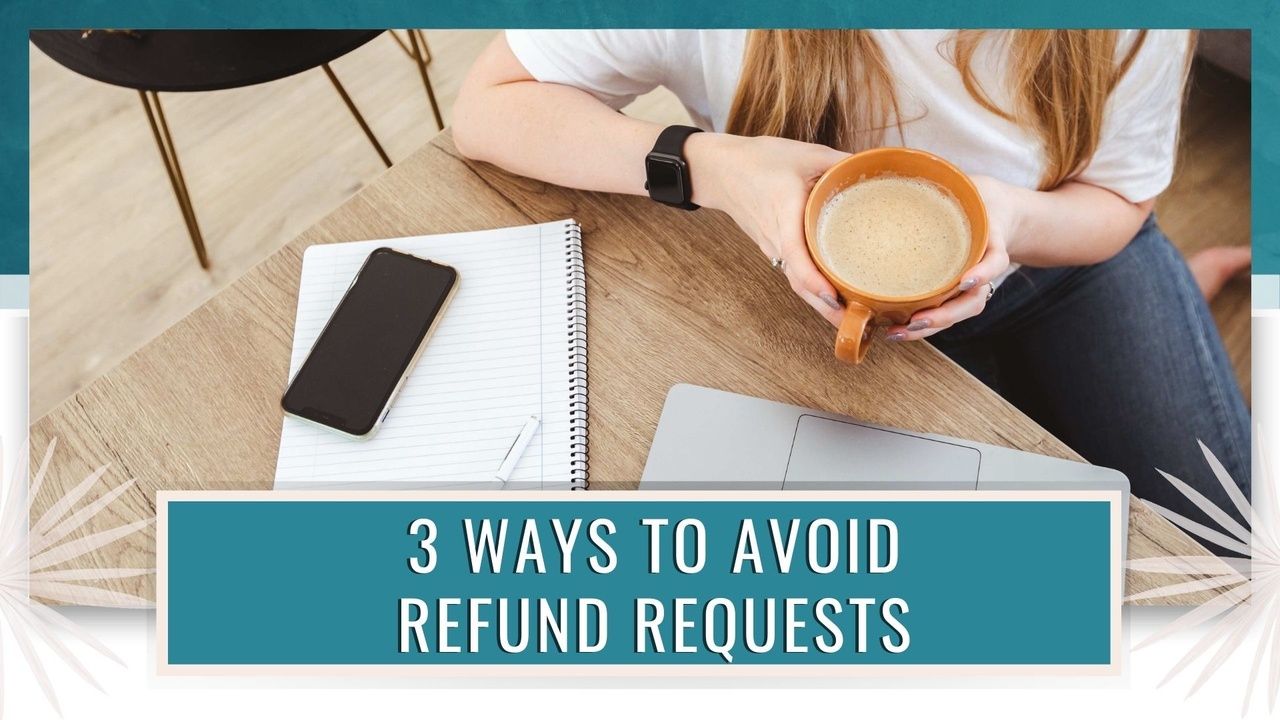Badass Is The New Black (Season 4) Episode #17- 3 Ways to Avoid Refund Requests
Jun 08, 2022
When we make a sale, the last thing we want is for our customer to reach back out and ask us for a refund. There are a number of reasons why this may happen. My hope today is that after you listened to this episode, you have some ideas on how to avoid this from happening.
Watch the episode here:
Listen to the podcast here:
3 Ways to Avoid Refund Requests
Today we're going to talk about how to avoid refund requests. When we make a sale, whether it's someone who joins your membership or someone who buys your course or your program, the last thing that we want is for them to jump in with us, to pay us and then reach back out and ask for a refund. My hope today is that after you listened to this episode, you have some ideas on how to avoid this from happening.
Having 0% is usually unavoidable. But if we can get that 2% to be very, very small, then that's great. We had a few refund requests when we first launched digital duplication academy and I was able to identify why this happened when we first launched it. Then I modified using some of these strategies that I'm going to teach you today. We had zero refund requests in the next two launches.

1. Set Clear Expectations
So number one, set expectations before someone purchases. I find this with my children all the time, I have to set expectations for whatever it is that we're doing. If I don't set expectations, they either are very disappointed, they have a complete meltdown or just something bad happens, right? But if we set expectations for our children, for our customers, then there's less likelihood of disappointment.
So it's summertime now, I have to kind of give my children the play by play. I'm like, what's going to happen? So first this is going to happen, then this is going to happen. Then I'm going to be done with work. Then we're going to go to the pool or we're going to do whatever, right? Setting the expectations so that they know what's coming and what to expect.
Now it's a little bit different with your customer. They have a decision to make, right? They're going to either jump in on your membership or your course or your program, and to make that decision to invest in whatever it is that they're investing with you. So we want to set expectations before they purchase. If their expectations are not set, they are going to purchase and if they have a totally different idea of what this is about, what they're going to get and how they're going to get there, they are going to find themselves in disappointment. Then they're going to be asking you for a refund.
So number one is set expectations before they purchase, tell them what is entailed in the program or the membership, what they're going to get, how they're going to receive it. Okay. Have some of those details like how long do they get access to it? You know, if it's a membership and it's an annual fee, make sure that they know that, right. Make sure that you are reminding them of their auto renewal. That's coming up now. I don't do auto renewal emails for someone who's paying a monthly membership. But for a year, if there's an annual subscription to something, then an email does go out. And I think that's even required by law to send out a notification, letting them know that their payment is going to process.
So do that, you know, at least a week before, not the day before people don't check their emails every day. So if someone does want to cancel your membership, for whatever reason they can do that before the payment goes through. Then you're avoiding a refund request, okay. Obviously the idea is that we are setting up our programs, we're adding values that people don't want to cancel, but that's just one example for a membership on how to avoid refund requests for that annual membership, but then any other program that's just a one-time cost, really setting the expectations so they know what to expect before they hit that purchase button. Okay.

2. Onboarding Process
Number two is setting up a really great onboarding process. So the more engaged someone gets, we talk about this a lot in digital duplication academy, because it really is. The third phase of the program is me teaching you how to set up an effective onboarding process. But really the whole idea here is to get your new customers to engage right away. So if you're providing a community space, we want them to engage in the community within the first day two or three,
to connect with someone, whether that's you or someone else in the community to connect with those people. So setting up a really amazing onboarding process to get them diving into the content. So if it's a community aspect and you have content for them to consume, make them tea, do something to make them take action right away, get them to and encourage them to watch that first video.
Maybe it's just your welcome video. And then maybe they have to respond to that video and take action to do something. Okay. So take a look at your onboarding process. If you don't have one, then maybe digital duplication academy is something that you need, but having a really great onboarding process is something that can really help decrease the refund requests. Again, people are getting involved in your content, they're getting engaged in your content and likely they're taking action then. And when people take action, they get results. And the more results people get, the less likely they are to ask for a refund.

3. Intake Form
Okay. And then the third thing that I like to do, which helps avoid refunds is an intake form to drive home the expectations and see where people might need help and offer that extra extra help. So again, the expectations before they purchase, maybe that's in my masterclass or on my sales page. Those are places where we can set expectations, but once they purchase, then my intake form where I'm gathering more data as an opportunity for me, again, to drive home expectations, how long is the program going to take? If they think they're going to get it done in four weeks, and then they fall behind, they're going to want a refund. Right? So setting realistic expectations of what this entails and driving that home again in an intake form and asking some questions to get them to acknowledge. So one of our intake form questions also is to gather some data for me to see where people are going to be at, where people might need some extra help, but I asked them how many hours do you have available to dedicate to building your website and your freebie funnel and your onboarding process, right?
Is it, is it five hours a week? Is it five to 10 hours, 10 to 15, 15 to 20. So I get an idea of where that person is and how much progress they are likely to be able to make over the course, the length of the program. Okay. And finding out other, or asking other questions to help you get an idea of where people might need help so that you can then either reach out to them and let them know of other resources that they might need to help get them launched, to get them started, you know, help them get that transformation that they want.
So the intake form just really allows you to drive the expectations home again, and gather some more information that can be super helpful for you to know where your people are at, where they might need extra help, and then provide that extra help when you can so that it doesn't have to be one-on-one help. Everyone is answering the questions and this gives you insight into what they are hoping to learn or where they need help so maybe you want to bring in an expert or add a bonus training. Maybe an SEO training or someone to help corporate women avoid burnout.

4. Having Good Email Support
And here's a little bonus one. This was not something I was going to talk about, but something that just popped into my head is having someone on your support email that can really allow your people to feel heard. Okay. And when you're responding, responding to emails, using their language that they're using to you, maybe they're say maybe they tell you, you know, I don't know, I, I'm not getting what I thought I was going to get out of this. First of all, that's an expectation thing. You likely didn't set the expectations appropriately in the very beginning, but making sure that the person who's responding. So if it's you responding to the support email, or you have an assistant that's doing that, that they use the same language that the person used to make them feel heard. And then you can also offer alternative solutions.
So I had a student recently that signed up for digital duplication academy and she said, my computer literally died within the week after signing up for this. And the cost is going to be a lot more than I anticipated. And so it's really put this whole thing on hold right now, because I clearly need a computer to work on my business. And on my website, you know, and asked for a refund. I just want to come back to this program at a later date. And so instead of just saying, okay, offering a refund, I got creative with it. And I said, you know what? Let's go ahead and pause your payments and that initial payment we'll hold your spot. Okay. And we'll go ahead and pause the payments for up to six months. You can take the time that you need to get your computer repaired. And then whenever you are ready within that six month timeframe, we can get you restarted and you can restart the program.
And she was ecstatic about that. I had another person also who was going through some health challenges and, you know, they reached out again like, oh, this is just a lot more time-consuming than their illness was allowing them to participate in the program. And so instead of just canceling altogether, I said, you know what, let's put it on pause and let's go ahead and have you come back. So we'll just pause your payments again, another payment plan that was pretty easy. If someone's doing a pay in full option, you could still keep the payment and offer that as an option. You know, we'll go ahead and keep the payment to save your spot for when you are ready to return. And, and we'll let you back in from the beginning, you can, you know, whatever it is.
So kind of thinking outside the box. So instead of refunding, we've just put things on a pause. They've already invested some money into the program, even with the payment plan, because they've made at least that first or second payment. So they've invested so likely they're more likely to come back knowing, and technically, you know, we've just paused it. And so the payments will start happening again after six months. And they're aware of that. And they know that and likely there'll be back before six months, but we gave them a bit of a leeway.
So there's different things that you can do to avoid those refund requests if they do come in, but they are a way less likely to come in if you're doing these three things, if you're setting the expectations before they purchase, not after, don't wait until your welcome video and your intake form, do it before they purchase. Number two, have a great onboarding process that really walks them through step-by-step of what they're going to be doing and getting them engaged right away. Then number three, have an intake form that can also drive home those expectations and allow you to gather some insights so that you can help better support the people that are coming into your community, your membership, your course, your program, whatever it is, so that you can help them get that transformation and avoid refund requests. And if they do ask for a refund, try and think outside the box on ways you can get creative to maybe pause something or give them the extra support that they need.
If you are building your business and you don't have a website yet, or maybe you have a website, but you know, there's some things falling short. I have a free masterclass for you. You can sign up for the wait list for the next time. It comes out. It's called how to build a wildly profitable website without knowing a thing about tech.
And I'm going to teach you how to target your perfect customer on your website, how to make it wildly profitable, how to turn your leads into customers on autopilot. It's summertime here. Like you guys I want to be at the pool. I want to be at the lake with my kids, doing things, having people be able to sign up for my free offerings and turn into customers on autopilot is such a blessing for time back in your schedule, to do the things that you want to do, whether it's spend more time, you know, on your business or spend more time with family, that automation piece is so key. So I'm going to teach you my strategy on how to make your website wildly profitable and turn those leads into customers. And then the third aspect of it is how to create engaged customers, that purchase again and again, or refer others to you and your business, because that is one of the ways that makes it wildly profitable.
Get on the waitlist for the next Website Masterclass here!
Important Links:
Biz & Life Lessons from the Quantum Level Up Retreat- Previous episode
Get on the waitlist for our next website masterclass!
Get on the waitlist for Digital Duplication Academy
Browse More Podcast Episodes!
Check out our most popular Masterclass,
"How to Automate Your Business and Increase Sales While You Sleep"
Get Instant Access!
We hate SPAM. We will never sell your information, for any reason.



